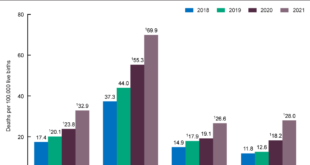There has been some talk in the news about increasing maternal mortality in the U.S. This is due to the new CDC report Maternal Mortality Rates in the United States, 2021 by Donna L. Hoyert (3/16/2023). The graph here is one from the report. Clearly the upward trend started before …
Read More »How has maternal mortality rates changed?
The chart here is from the National Center for Health Statistics paper Maternal Mortality Rates in the United States, 2020 by Donna L. Hoyert (2/23/2022). A definition: A maternal death is defined by the World Health Organization as, “the death of a woman while pregnant or within 42 days of …
Read More »What is the connection between flu and humidity?
The NASA post NASA Finds Each State Has Its Climatic Threshold for Flu Outbreaks (3/4/2022) summarizes the recent paper Spatial Variation in Humidity and the Onset of Seasonal Influenza Across the Contiguous United States by E. Sherman, et. el (12/13/2021). From the NASA Post: Researchers at NASA’s Jet Propulsion Laboratory …
Read More »What are the trends in drug overdose deaths?
The Pew article Recent surge in U.S. drug overdose deaths has hit Black men the hardest by John Gramlich (1/19/2022) provides the graph copied here. Nearly 92,000 Americans died of drug overdoses in 2020, marking a 30% increase from the year before, a 75% increase over five years and by far the …
Read More »How does life expectancy in the U.S. compare to other countries?
Our World in Data has the answer and more on their page Why is life expectancy in the U.S. lower than in other rich countries? In the US health spending per capita is up to four times higher, yet life expectancy is lower than in all of these countries. The …
Read More »What is the connection between life expectancy and education?
The PNAS paper Life expectancy in adulthood is falling for those without a BA degree, but as educational gaps have widened, racial gaps have narrowed by Anne Case and Angus Deaton (3/16/2021) provides an answer. From the abstract: We construct a time series, from 1990 to 2018, of a summary …
Read More »What is the connection between crime and lead?
Kevin Drum asks a good question in his post How Many Cops Does New York City Need? First note that violent crime has been dropping since around 1990 (see his graph copied here for examples). In particular for NYC: The per capita number of police officers increased by about 10 …
Read More »How does C-19 deaths compare to other causes of deaths in the U.S.?
Here is an excellent animated visualization of daily deaths of C-19 as compared to other leading causes of deaths in the U.S. This chart stops at April 14. According to Worldometers here are the number of daily deaths from April 15 through April 22: 2618, 2176, 2538, 1867, 1561, 1939, …
Read More »C-19, counts or per capita?
The media tends to focus on the number C-19 deaths in a country, but per capita provides a better understanding of the impact in a country. The Our World in Data page Coronavirus Disease (COVID-19) – Statistics and Research page has interactive graphs for per capita deaths. For example, currently …
Read More »Who posts C-19 data?
If you are looking for COVID-19 data there are two good resources. The first is the Our World in Data Cornonavirus page by Max Roser, Hannah Ritchie, and Esteban Ortiz-Ospina. They have a number of interactive graphs, such as the one copied here where you can select countries to view, …
Read More »